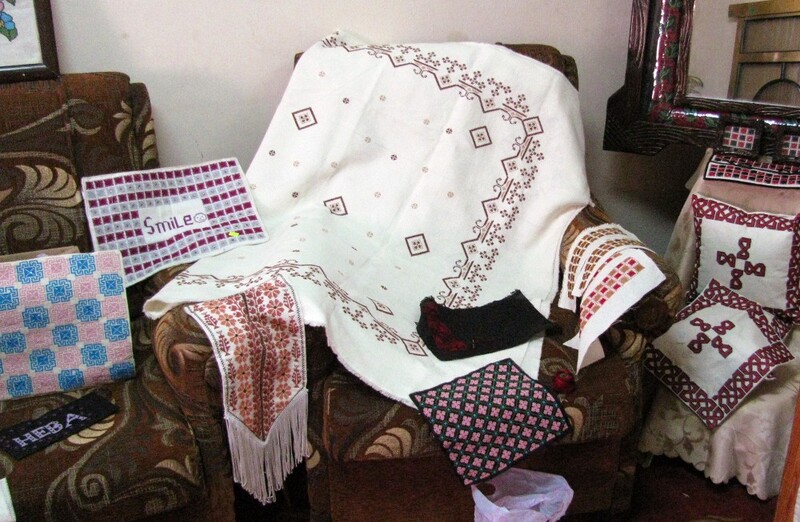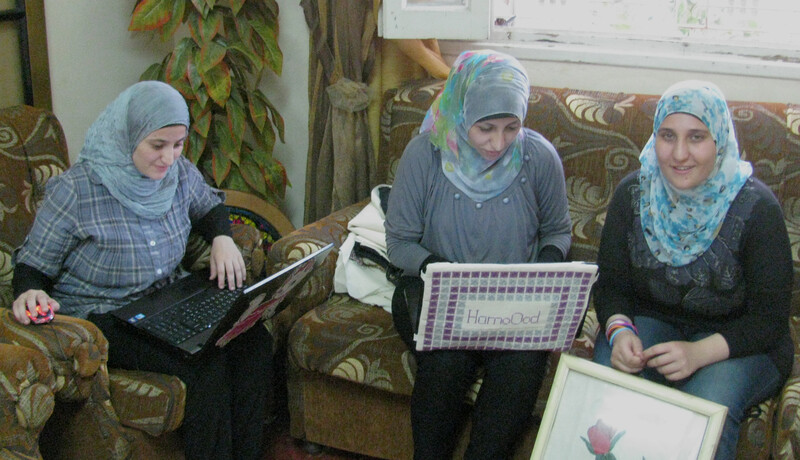The Electronic Intifada Gaza City 23 October 2012

Some of the Six Flowers’ work
The Electronic IntifadaThey call themselves the Six Flowers. They’re not the regular type of flower you’d find in a garden, but you will find them in Gaza City’s al-Tuffah neighborhood, off an unpaved road.
At their two-story family house, surrounded by fruit trees, six sisters spend most of their time creating handmade embroidery in the Palestinian folkloric tradition but using their own designs and innovations. The sisters are: newlywed Nour, 26; Budour, 23, and a graduate in social studies; Nadreen, 24, an arts graduate; Basma, 20, a community rehabilitation graduate; Aya, 19, medical analysis student, and Hiba, a 17-year-old high school student.
“My sister Nour recently got married and we would have loved that most of her newly-furnished home should contain handmade decorations from our Palestinian folklore. We made some towels decorated with colorful beads and some bathroom things like the mirror frame and many others like a box of spoons that is made of wood and some colorful beads,” explained Budour Nahid Shushaa, who runs the sisters’ “Six Flowers” Facebook page.
Nadreen, with her arts background, takes the lead in designing patterns for the various items the women make — from cushion covers, table cloths, wallets and purses, trays, slippers, baby booties and blankets, picture frames and unique pieces depicting images and messages. She also carefully selects the wool and colors and prepares the material.
“For the past eight years, we have been working at home, using it as means to achieve something for ourselves and also to use our time in useful activities,” Budour told The Electronic Intifada. “In summer, for example, we as school girls didn’t have much time or chance to go outdoors, so we wanted to do something useful. While we were sitting right in this balcony, we decided to create a Facebook account with the name Six Flowers.”
Nour, who studied computer science, recently told a Gaza TV show that part of the reason the sisters kept at the work was because even with their university educations the unemployment situation made it hard to find positions their qualifications would be useful for. But even after Nour found work, she kept her commitment to the project.
Although the sisters have been making their wares and showing them around Gaza, they saw the Facebook page as a way to reach even more people. The page displays images of some of the sisters’ intricate embroidery and videos of TV interviews they have done.
Work and identity

Budour, Nadreen and Basma Shushaa
The Electronic IntifadaMany people in the Gaza Strip prefer handmade items and exchange them as gifts.
“Sometimes our relatives who live abroad, such as in the Gulf countries or Western countries like the US, buy some handmade gifts from us,” said Budour, who handles media inquiries for the sisters. “Last year our uncle bought some gifts from us and we were happy that our works were shown in the US.”
“This [work] represents for me both an identity and a hobby,” said high school student Hiba. “There is nothing more beautiful than our own Palestinian cultural heritage of handmade works and decorations,” she said as she showed off some of her creations (including contemporary adaptions such as mobile phone cases) to The Electronic Intifada.
Many of the sisters’ works, including images and symbols for local organizations, are displayed on the walls of the living room of the house of their father, Nahid Shushaa, which doubles as their workshop.
“This image that includes a key belongs to one of the local organizations, called Rajeen [We are Returning],” said Aya, gesturing to one of the creations. “When we were asked to create a symbol for that NGO, we thought of the key, which symbolizes the return to our homeland.”
Aya also contributed a fabric creation which depicts a ship bearing the Palestinian flag.
“This represents for me the ships of peace convoys, which attempt to break the Israeli siege,” Aya explained. “I was actually inspired [to make it] by the Israeli attack on the flotilla in 2010.”
Intricacy and difficulty
“Sometimes a piece of work takes us about two months,” Nadreen said, but “sometimes, while we are in the middle of the work of something, we find out that a certain color of a string used in the making is lacking in the local market, so we always make sure that all raw materials needed are available beforehand.”
Other challenges she said the sisters face are the lack of special exhibitions in Gaza to sell such work.
“Some of the works we make here are embroidered laptop covers. We thought of that as a way to combine modern technology and folkloric tradition. But the price for this is too high for many people, simply because we need to send such covers, and other items to specialized people who can add important touches to them.”
Looking forward
The Six Flowers dream of having a place like a workshop to make their own things in and of exhibiting their works in different parts of the Gaza Strip.
“We’d like to train other women, including widows, impoverished women and university graduates who can’t find work, on how to make such folkloric works, so that they can rely on themselves in the future,” said Budour.
“However, we lack a space for that and also we lack a space for our own work, or a place where we can exhibit. Once we had a corner within a local university’s exhibition and this worked well as some visitors bought some of our work,” she explained.
Inspiration and support from family
Nahid Shushaa, father of the six sisters and a retired Palestinian Authority construction official, is proud of what his daughters have achieved.
“I give them full support to the extent that I helped them get driving licenses and I let them use my own car to bring material or take part in exhibitions. Bringing up your daughters to be strong is the best way to let them never worry even in the worst circumstances,” said Abu Mustafa, who has a 16-year-old son called Mustafa, as well as his six daughters.
While the women work, their grandmother, Umm Nahid, now in her eighties, and originally from Nablus in the West Bank, is always nearby.
“During my youth in Nablus and before I moved to Gaza back in 1945, I used to be such a talented embroiderer, just like the girls,” she said. “I recall that I used to be very selective in colors for the various decorations and arts from our Palestinian folklore,” she remembered. “Up to this moment, I help with the girls’ works by helping them coordinate the various beautiful colors.”
With their family’s encouragement, the Six Flowers are ensuring that a Palestinian tradition flourishes and finds new forms.
Rami Almeghari is a journalist and university lecturer based in the Gaza Strip.





